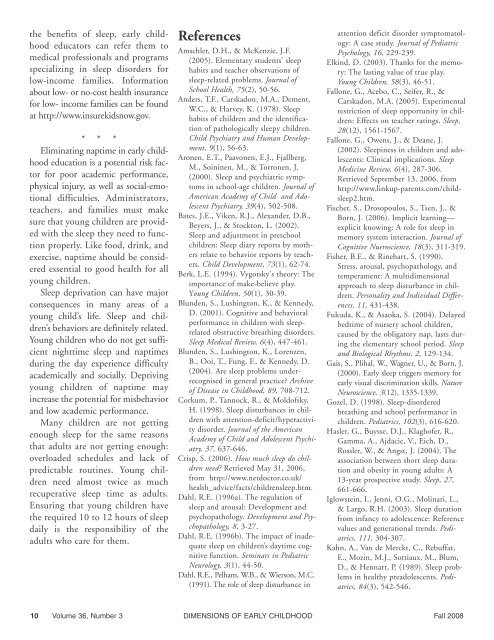Five Essential Reasons to Keep Naptime in the - Southern Early ...
Five Essential Reasons to Keep Naptime in the - Southern Early ...
Five Essential Reasons to Keep Naptime in the - Southern Early ...
Create successful ePaper yourself
Turn your PDF publications into a flip-book with our unique Google optimized e-Paper software.
<strong>the</strong> benefits of sleep, early childhood<br />
educa<strong>to</strong>rs can refer <strong>the</strong>m <strong>to</strong><br />
medical professionals and programs<br />
specializ<strong>in</strong>g <strong>in</strong> sleep disorders for<br />
low-<strong>in</strong>come families. Information<br />
about low- or no-cost health <strong>in</strong>surance<br />
for low- <strong>in</strong>come families can be found<br />
at http://www.<strong>in</strong>surekidsnow.gov.<br />
* * *<br />
Elim<strong>in</strong>at<strong>in</strong>g naptime <strong>in</strong> early childhood<br />
education is a potential risk fac<strong>to</strong>r<br />
for poor academic performance,<br />
physical <strong>in</strong>jury, as well as social-emotional<br />
difficulties. Adm<strong>in</strong>istra<strong>to</strong>rs,<br />
teachers, and families must make<br />
sure that young children are provided<br />
with <strong>the</strong> sleep <strong>the</strong>y need <strong>to</strong> function<br />
properly. Like food, dr<strong>in</strong>k, and<br />
exercise, naptime should be considered<br />
essential <strong>to</strong> good health for all<br />
young children.<br />
Sleep deprivation can have major<br />
consequences <strong>in</strong> many areas of a<br />
young child’s life. Sleep and children’s<br />
behaviors are def<strong>in</strong>itely related.<br />
Young children who do not get sufficient<br />
nighttime sleep and naptimes<br />
dur<strong>in</strong>g <strong>the</strong> day experience difficulty<br />
academically and socially. Depriv<strong>in</strong>g<br />
young children of naptime may<br />
<strong>in</strong>crease <strong>the</strong> potential for misbehavior<br />
and low academic performance.<br />
Many children are not gett<strong>in</strong>g<br />
enough sleep for <strong>the</strong> same reasons<br />
that adults are not gett<strong>in</strong>g enough:<br />
overloaded schedules and lack of<br />
predictable rout<strong>in</strong>es. Young children<br />
need almost twice as much<br />
recuperative sleep time as adults.<br />
Ensur<strong>in</strong>g that young children have<br />
<strong>the</strong> required 10 <strong>to</strong> 12 hours of sleep<br />
daily is <strong>the</strong> responsibility of <strong>the</strong><br />
adults who care for <strong>the</strong>m.<br />
References<br />
Amschler, D.H., & McKenzie, J.F.<br />
(2005). Elementary students’ sleep<br />
habits and teacher observations of<br />
sleep-related problems. Journal of<br />
School Health, 75(2), 50-56.<br />
Anders, T.F., Carskadon, M.A., Dement,<br />
W.C., & Harvey, K. (1978). Sleep<br />
habits of children and <strong>the</strong> identification<br />
of pathologically sleepy children.<br />
Child Psychiatry and Human Development,<br />
9(1), 56-63.<br />
Aronen, E.T., Paavonen, E.J., Fjallberg,<br />
M., So<strong>in</strong><strong>in</strong>en, M., & Torronen, J.<br />
(2000). Sleep and psychiatric symp<strong>to</strong>ms<br />
<strong>in</strong> school-age children. Journal of<br />
American Academy of Child and Adolescent<br />
Psychiatry, 39(4), 502-508.<br />
Bates, J.E., Viken, R.J., Alexander, D.B.,<br />
Beyers, J., & S<strong>to</strong>ck<strong>to</strong>n, L. (2002).<br />
Sleep and adjustment <strong>in</strong> preschool<br />
children: Sleep diary reports by mo<strong>the</strong>rs<br />
relate <strong>to</strong> behavior reports by teachers.<br />
Child Development, 73(1), 62-74.<br />
Berk, L.E. (1994). Vygotsky's <strong>the</strong>ory: The<br />
importance of make-believe play.<br />
Young Children, 50(1), 30-39.<br />
Blunden, S., Lush<strong>in</strong>g<strong>to</strong>n, K., & Kennedy,<br />
D. (2001). Cognitive and behavioral<br />
performance <strong>in</strong> children with sleeprelated<br />
obstructive breath<strong>in</strong>g disorders.<br />
Sleep Medical Review, 6(4), 447-461.<br />
Blunden, S., Lush<strong>in</strong>g<strong>to</strong>n, K., Lorenzen,<br />
B., Ooi, T., Fung, F., & Kennedy, D.<br />
(2004). Are sleep problems underrecognised<br />
<strong>in</strong> general practice? Archive<br />
of Disease <strong>in</strong> Childhood, 89, 708-712.<br />
Corkum, P., Tannock, R., & Moldofsky,<br />
H. (1998). Sleep disturbances <strong>in</strong> children<br />
with attention-deficit/hyperactivity<br />
disorder. Journal of <strong>the</strong> American<br />
Academy of Child and Adolescent Psychiatry,<br />
37, 637-646.<br />
Crisp, S. (2006). How much sleep do children<br />
need? Retrieved May 31, 2006,<br />
from http://www.netdoc<strong>to</strong>r.co.uk/<br />
health_advice/facts/childrensleep.htm.<br />
Dahl, R.E. (1996a). The regulation of<br />
sleep and arousal: Development and<br />
psychopathology. Development and Psychopathology,<br />
8, 3-27.<br />
Dahl, R.E. (1996b). The impact of <strong>in</strong>adequate<br />
sleep on children’s daytime cognitive<br />
function. Sem<strong>in</strong>ars <strong>in</strong> Pediatric<br />
Neurology, 3(1), 44-50.<br />
Dahl, R.E., Pelham, W.B., & Wierson, M.C.<br />
(1991). The role of sleep disturbance <strong>in</strong><br />
attention deficit disorder symp<strong>to</strong>ma<strong>to</strong>logy:<br />
A case study. Journal of Pediatric<br />
Psychology, 16, 229-239.<br />
Elk<strong>in</strong>d, D. (2003). Thanks for <strong>the</strong> memory:<br />
The last<strong>in</strong>g value of true play.<br />
Young Children, 58(3), 46-51.<br />
Fallone, G., Acebo, C., Seifer, R., &<br />
Carskadon, M.A. (2005). Experimental<br />
restriction of sleep opportunity <strong>in</strong> children:<br />
Effects on teacher rat<strong>in</strong>gs. Sleep,<br />
28(12), 1561-1567.<br />
Fallone, G., Owens, J., & Deane, J.<br />
(2002). Sleep<strong>in</strong>ess <strong>in</strong> children and adolescents:<br />
Cl<strong>in</strong>ical implications. Sleep<br />
Medic<strong>in</strong>e Review, 6(4), 287-306.<br />
Retrieved September 13, 2006, from<br />
http://www.l<strong>in</strong>kup-parents.com/childsleep2.htm.<br />
Fischer, S., Drosopoulos, S., Tsen, J., &<br />
Born, J. (2006). Implicit learn<strong>in</strong>g—<br />
explicit know<strong>in</strong>g: A role for sleep <strong>in</strong><br />
memory system <strong>in</strong>teraction. Journal of<br />
Cognitive Nueroscience, 18(3), 311-319.<br />
Fisher, B.E., & R<strong>in</strong>ehart, S. (1990).<br />
Stress, arousal, psychopathology, and<br />
temperament: A multidimensional<br />
approach <strong>to</strong> sleep disturbance <strong>in</strong> children.<br />
Personality and Individual Differences,<br />
11, 431-438.<br />
Fukuda, K., & Asaoka, S. (2004). Delayed<br />
bedtime of nursery school children,<br />
caused by <strong>the</strong> obliga<strong>to</strong>ry nap, lasts dur<strong>in</strong>g<br />
<strong>the</strong> elementary school period. Sleep<br />
and Biological Rhythms, 2, 129-134.<br />
Gais, S., Plihal, W., Wagner, U., & Born, J.<br />
(2000). <strong>Early</strong> sleep triggers memory for<br />
early visual discrim<strong>in</strong>ation skills. Nature<br />
Neuroscience, 3(12), 1335-1339.<br />
Gozel, D. (1998). Sleep-disordered<br />
breath<strong>in</strong>g and school performance <strong>in</strong><br />
children. Pediatrics, 102(3), 616-620.<br />
Hasler, G., Buysse, D.J., Klaghofer, R.,<br />
Gamma, A., Ajdacic, V., Eich, D.,<br />
Rossler, W., & Angst, J. (2004). The<br />
association between short sleep duration<br />
and obesity <strong>in</strong> young adults: A<br />
13-year prospective study. Sleep, 27,<br />
661-666.<br />
Iglowste<strong>in</strong>, I., Jenni, O.G., Mol<strong>in</strong>ari, L.,<br />
& Largo, R.H. (2003). Sleep duration<br />
from <strong>in</strong>fancy <strong>to</strong> adolescence: Reference<br />
values and generational trends. Pediatrics,<br />
111, 304-307.<br />
Kahn, A., Van de Merckt, C., Rebuffat,<br />
E., Moz<strong>in</strong>, M.J., Sottiaux, M., Blum,<br />
D., & Hennart, P. (1989). Sleep problems<br />
<strong>in</strong> healthy preadolescents. Pediatrics,<br />
84(3), 542-546.<br />
10 Volume 36, Number 3 DIMENSIONS OF EARLY CHILDHOOD Fall 2008
















